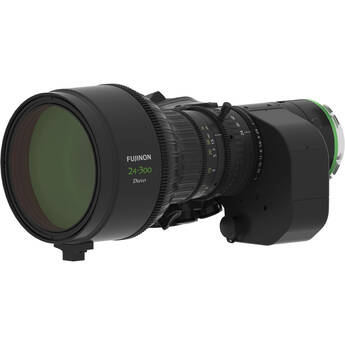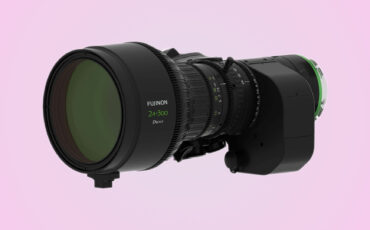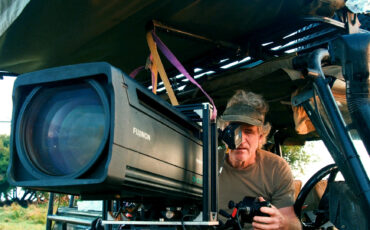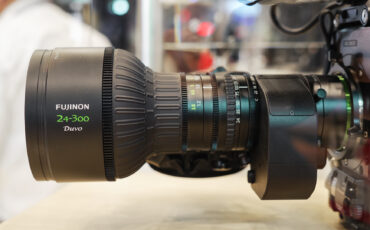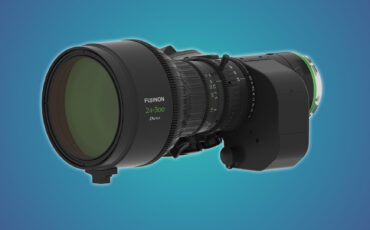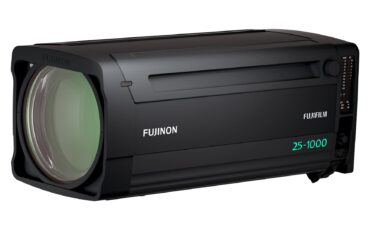FUJINON Duvo HZK24-300mm Lens Review
Restriction-free music courtesy of Epidemic Sound. Sign up here: Epidemic
FUJINON, a wholly owned subsidiary of FUJIFILM, is having a bit of a moment with their recently released PL “box style” lens, and now with a further expansion of the “Duvo” line in the form of a nifty 24-300mm T2.9 zoom with 9 iris blades. Despite only having the zoom for a few days, I was able to put it through its paces on a few different types of productions as I searched for what we all look for: the one lens to rule them all. So, is this the one? You’ll have to watch/read this review of the FUJINON Duvo HZK24-300 PL Zoom lens to find out.
First, the basics – the Duvo T2.9 24-300mm, priced at $31,999, is designed to cover 2/3″, 1/2″, and 1/3″ sensors in 16:9. I used it with my trusty Canon C500MKII with PL mount so that I could try it out in both full-frame and S35 mode. If you are in full-frame or S35 mode on the C500MKII, the zoom lens is a standard 24-300mm (12.5x zoom). If you use the built-in expander in S35 mode, you suddenly have a 36-450mm zoom as the focal length shifts by 1.5x. It is worth pointing out that the lens stops down to a T4.2 when zoomed in to 300mm.
The lens covers a 28.5mm Super 35 sensor across the entire zoom range or a 41.3mm sensor in full frame mode (simply click the extender back and forth to switch coverage). You’ll very quickly see heavy vignetting if you have your lens extender in the S35 setting when your camera is set to full frame, and that should prompt you to change settings either in-camera or with the little extender toggle at the side of the zoom.

The ability to hop to 300mm or 450mm in a zoom that is 6.5 lbs (2.95 kg) is exciting, and using a full-frame camera with an S35 mode seems to be the best way to increase the versatility of this zoom all around. This lens’s weight tends to settle on the wrist while filming, so I found myself carefully balancing the battery at the back of the camera to be a bit further back on the rods. That way, it felt a little more balanced on my shoulder while filming a chef run-and-gun style.
The Art & Science of Lenses
In the video above, you can see the lens in full action!
While filming this short documentary at a restaurant in San Diego, California, I found myself shooting in full-frame mode on the camera and then S35 mode on the lens to get messier edges to add a bit of a fun vignette on the closeup shots of the food. We then cropped in slightly in post to avoid seeing hard edges. It’s just a tiny creative choice there, but one that you could experiment with when you have a lens with so many options!
Initial impressions
Early in my career, I shot major league baseball in the United States. Taking the Duvo 24-300mm out of the box for the first time gave me flashbacks to that time in my work life – the exterior looks and feels like a broadcast or live-events lens. Indeed, you can’t remove the servo motor unit from the side of the lens even if you want to for more cinema-like applications.
The servo unit itself feels standard in the sense you can tune the speed of your zooms using a tiny knob (much like tension settings on a tripod), and I know every operator has a preference here. The zoom sports a large 114mm front diameter, but this lends itself to various matte box options. A quick search reveals plenty of relatively affordable clip-on matte box solutions from all your favorite camera accessories brands.
You could also use the included lens hood, a 127mm filter thread, for mounting various types of ND filters if you don’t have in-camera ND solutions or polarizer filters from brands like Tiffen, Formatt Hitech, or Urth.

FUJINON employs 0.8 pitch gears in this lens, so you can absolutely use various follow-focus options that are more standard for non-live film and television. Still, I felt very, very comfortable pulling my own focus with this setup. The front focus ring has grippy rubberized material (a highly technical term I’ve invented here) that makes focusing a breeze. You could also easily focus yourself while shouldered and wearing gloves. The focus throw of this lens also feels optimized for an operator pulling their own focus.
To power the lens and the attached servo unit, you’ll need to consider some type of 12-pin power solution. Canon, for example, has a $2000 expansion plate for the C300MKIII and the C500MKII that has a 12-pin interface for lens power, but I needed to use a D-Tap to 12-pin cable to allow for my servo to receive power. A quick Google search brings up a bunch of different cable options here, and none of them are terribly expensive.
Back focus is very easy to change with this zoom, and here is a quick explainer video that shows just how easy it is:
The FUJINON team also told me you can change the back focus remotely, but I didn’t have a live production truck available for this field test to try out that particular feature so I’ll take them at their word!
The Look
If, like me, you’ve spent years in the more traditional world of film and television away from broadcast shooting, then you won’t find that the Duvo 24-300mm has a great deal of character from a look perspective. I don’t mean this as a negative. Lately, I’ve been spending a bunch of time with some rehoused Soviet glass, and the Duvo 24-300mm is the opposite look of vintage lenses, with an evident effort made by FUJINON to control flares and reduce distortion around the edges of the glass.

As to the color, it’s mostly neutral. I found the out-of-focus areas to be lovely when shooting near the telephoto side of the range closer to 300mm. The Duvo 24-300mm is sharp, but it isn’t the sharpest zoom I’ve used. It’s well suited to filming humans in closeups and probably without the need for softening filtration.
There is focus breathing (expected on a zoom with a dramatic focal range like this), though I didn’t find it distracting. Your own particular tastes about what level of focus breathing is acceptable to you will of course play a factor here.

The look of this zoom makes sense when you think of it as a broadcast or live events solution, and if you were filming a quick-moving doc or scripted project, you could absolutely shake up the image with some type of look filtration.
Use cases
Given the $31,999 price tag, the FUJINON Duvo HZK24-300mm is likely a rental item for many, but large broadcast and live events organizations won’t shy away from that price tag as this feels like a zoom that will be in the mix for years to come.
I’ve been lucky enough to shoot many different types of genres over the years, from sports to live events to documentaries, as well as commercial and scripted projects, and I’m always looking for the one lens I can mount on my camera and never change out for the entirety of the project. The Duvo 24-300mm is almost exactly that. True, the 24mm isn’t quite wide enough in all shooting scenarios, but on the long end, I found 300mm and 450mm (in S35 mode) to be great for the types of things I usually shoot.
As a test, I plopped my tripod down on the beach and did a quick b-roll pass on everything around me – how many different types of shots could I get without moving my tripod once? The answer is jaw-dropping. I spent several minutes picking up shots all over the beach, and this speaks to where this zoom really shines. If you have a short time to get a bunch of shots before hopping back into a crew vehicle, this is the lens for you.
There is also a macro setting that allows you to quickly get extremely tight on a subject. You can see macro mode engaged on a few shots of the food in the mini-doc I shot on this Zoom.

In fact, there have been dozens of days in my career where I’ve had to grab a bunch of cutaways in some far-flung location, and the Duvo 24-300 would have been the lens for the job. Think of it – you pull over at some vista, and suddenly you are grabbing all your mountain-wide shots, your slow-motion shots of eagles flying by, a quick timelapse of some clouds drifting over a distant peak, and then maybe a medium shot of some signage and boom – back in the vehicle you go. How cool is that?
I also find the flare handling in the Duvo 24-300mm to be excellent and not distracting. That suggests it would be a good solution for live concerts where hard lights are often moved unexpectedly mid-shot with the result that they aim directly into your camera position.

Sports shooters will also find the easy-focusing Duvo 24-300mm simplifies following action by having the right hand on the servo and the left hand pulling focus. One thing to keep in mind is that the overall length of the lens is 10.6 inches in addition to whatever camera body you are using, so you do end up with a fairly long form factor.
No, the combination of this zoom and a mid-sized camera is not the lightest thing in an industry rife with small mirrorless camera options and short flange optics. Still, compared to broadcast setups of old, things are much, much easier on operators these days. Snag an Easyrig or Ergorig, and you’ll have nothing to worry about.
Conclusion
These days, FUJINON just might be the best option for servo-capable zooms for use in live events and broadcasts as many optics manufacturers are devoting their precious R&D bucks to short flange cine primes and even affordable anamorphic options, leaving FUJINON to press on in a bustling market segment that shows no signs of slowing down.
The Duvo HZK24-300mm promises to be a go-to in live events and broadcasts, and the occasional documentary or reality shooter will find much to love here, too. The ubiquitous PL mount means this will be a lens that finds a home on camera bodies for years and years to come. It will also likely retain its resale value, making that $31,999 price tag a bit easier to handle, depending on your market.
After only a few days with this Zoom, I grew to love its ease of use, operator-friendly weight, and button arrangement. FUJINON clearly listens to their users, and the results show.

What do you think? Will the FUJINON Duvo HZK24-300mm PL zoom find a place on your next production? Let us know in the comments below!
